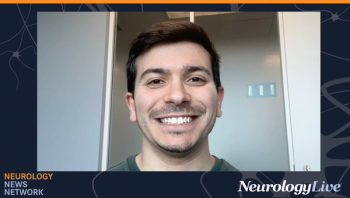
Nusinersen: The First Approval for Spinal Muscular Atrophy
Nancy L. Kuntz, MD: One of the things we want to make sure to talk about today is the exciting translational research that has led to new treatments in spinal muscular atrophy [SMA]. This is truly a new generation. I’d like to begin by talking about the first FDA approved treatment in spinal muscular atrophy. I know, Basil, you were very involved in many of these clinical trials, and perhaps you can describe them.
Basil Darras, MD: I would be happy to, Nancy. As we discussed earlier, the SMN2 gene is a major phenotypic modifier, but also has become the target of pharmaceutical research. And the effort is that they’re trying to increase projection of full-length SMN protein from the SMN2. And 1 of the efforts involved the development of an antisense oligonucleotide, which is a small piece of synthetic nucleic acid, which was designed to improve the splicing of the SMN2 gene. So as we said earlier, the splicing is defective in this division for the production of only about 10% of full-length protein.
So there’s a lot of basic science behind this development, which went on for years, to identify a particular binding site that, if inactivated, will enhance the splicing of the SMN2 gene. They screened a large number of oligonucleotides, and 1 of them was found to be effective in that regard. It binds to a particular site in intron 7 next to exon 7, and by doing so it does displace particular proteins that binds to the same site, which is a splicing repressor. And by inhibiting this particular repressor protein binding, it increases the splicing of the inclusion of exon 7 to the splicing events.
Instead of having something in the range of 10%, in animals we’re able to push it up as high as 90%, 95%. So they, after a number of successful experiments in laboratory animals, moved on to researching in humans using this piece of nucleic acid to be antisense oligonucleotide, initially known as SMNRx. And we had the initiation of clinical trials back in 2012 with a single dose given intrathecally by spinal tap.
And the reason for that is that this oligonucleotide does not cross by the brain barrier, so it has to be given by intrathecal injection. And a single injection proved to be safe, and then we moved to multiple injections with different doses, and at some point, it became apparent that a particular dose seemed to be effective. It specifically was 9 mg. And after that they moved up to 12 mg. So the studies continued to the beginning in open-label fashion, as we say, without having a control arm, and they seemed to show that the medication was safe and probably effective.
So it was in August 2014 when the ENDEAR study started for type 1 babies, the severe form of SMA, in a large number of centers, not only the United States but also internationally, which included not only a treatment arm—approximately 80 babies with SMA type 1—but also a control arm, what we called a sham procedure control arm because we don’t actually give them the medication. We just perform a sham procedure, pretending that we’re doing a spinal tap.
There was a control arm of the study. It lasted for approximately 13 months. And after an interim analysis in the summer of 2016, it became apparent that there was some degree of efficacy. In fact, the study was terminated somewhat prematurely because the data seemed to be positive. And they’re positive in the sense that these babies were able to increase a particular score, known as the CHOP INTEND [Children’s Hospital of Philadelphia Infant Test of Neuromuscular Disorders] score, which measures more function in infants. But also we noted if there was acquisition of development milestones like head control, sitting, and things like that. And of course, we noticed that the muscle strain was increased in the upper and lower extremities.
In summary, there was an interim analysis that showed that about 41% of the babies in the treatment arm had some kind of motor milestone response versus 0% of the sham control. And that was sufficient to indicate that the medication actually was working. At the end of the study, the final analysis in fact, the percentage of responders was 51% versus 0% in the sham control group.
After this very positive finding, a decision was made to submit an application to the FDA, which included the results of the open-label studies that were conducted for a number of years going back to 2012. And that led to the approval of nusinersen as the first treatment for SMA but also for all types of SMA regardless of age.
So although the approval was based primarily on type 1 results, some decided to approve it for all types of SMA. And we started treating all types of patients from very severe to less severe: from babies with severe form to the sitters or walkers. And it’s given intrathecally by spots spinal tap, 4 loading doses and then 1 dose every 4 months. We have treated a significant number of patients at not only our site but also other sites around the country and around the world.
Nancy L. Kuntz, MD: And there has been not only the sham-controlled double-blinded study in infants but also 1 in slightly older children, the sitters.
Basil Darras, MD: Exactly.
Nancy L. Kuntz, MD: And another 1 that’s monitoring some presymptomatic children, I understand.
Basil Darras, MD: Correct.
Nancy L. Kuntz, MD: What would you say the most important lesson you learned from these studies?
Basil Darras, MD: We learned that this theoretical idea that you can correct the splicing of the SMN2 actually can work in humans, but as Elizabeth said earlier, it’s not actually a cure for SMA; it’s only a treatment with different types of responses from mild improvement to significant improvement, or only to stabilization of function.
Nancy L. Kuntz, MD: And I think also in comparing the outcomes and the change over time in these various treatment groups, it appears very clearly that children with the same number of copies who were treated earlier do better.
Basil Darras, MD: Correct.
Nancy L. Kuntz, MD: And I think this is where a lot of the impetus for early identification and newborn screening is coming from.
Basil Darras, MD: Yes.
Newsletter
Keep your finger on the pulse of neurology—subscribe to NeurologyLive for expert interviews, new data, and breakthrough treatment updates.



























